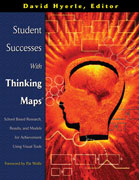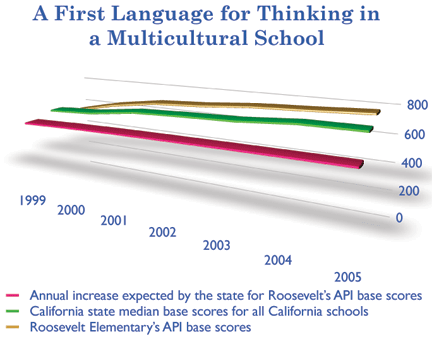



 dent Successes With Thinking Maps®
dent Successes With Thinking Maps®David Hyerle, editor with Sarah Curtis and Larry Alper co-editors
Chapter 11: A First Language for Thinking
in a Multilingual School
Stefanie R. Holzman, Ed.D.
“The Thinking Maps took the English language learner to the highest level of thinking . . . in a very simple way.”
Teacher
Many of the teachers in this urban, inner city, K–5 school of 1200 minority students (85% of those entering with Spanish as their primary language) thought they were already getting the best out their students. As the newcomer to the school, I had expectations that students should be achieving at higher levels than current test results indicated.
My high expectations are rooted in an understanding of what many of us who have attempted to learn a second language know: Learning content while learning a second language is a complex process. It is frustrating for a child to have ideas, vocabulary, and rich patterns of thinking in one language that are not immediately translated and understood by teachers in the context of the classroom. This is because the acquisition of a second language obviously gets in the way of our thinking and learning. The Thinking Maps become a translator of language and thinking from one language-mind (Spanish) to another language-mind (English). Thinking Maps became our first language for thinking, thus supporting the languages, content learning, and cognitive development of our multilingual population.
My experiences from seeing the maps in use in other schools in Long Beach Unified School District made me believe that our students would learn the maps, and the result of all this would be higher academic achievement. This did happen. The numbers are in from the standardized tests given in California. The state has a very complicated formula to determine expected growth. Roosevelt school was expected to gain 11 points overall. We exceeded that goal with a 60 point gain. Not only did the school as a single unit make growth, but so did our significant subgroups: Hispanic students, English language learners, and students of low socioeconomic status as determined by free lunches. 
View the movie clips below with Quicktime. The video clip below is a Quicktime video. If you see the video, you have the Quicktime plug-in. Click the play button and watch. If you do not see the video, click here to download the Quicktime plug-in (Windows and Macintosh).
Differentiation in a Multilingual School
Stephanie Holzman, principal of Roosevelt Elementary School is interviewed in a classroom about differentiation by David Hyerle. The video clip below is a Quicktime video. If you see the video, you have the Quicktime plug-in. Click the play button and watch. If you do not see the video, click here to download the Quicktime plug-in (Windows and Macintosh).
![]() If you prefer the Windows Media Player version of the video clip below click here to watch.
If you prefer the Windows Media Player version of the video clip below click here to watch.
Read the complete chapter in the book Student Successes With Thinking Maps. Key sections from the chapter A First Language for Thinking in a Multilingual School with excerpts above include:
- Breaking the Rules for Change
- Teacher Learning
- Teachers Teaching at Higher Order
- Differentiation of Instruction and English as a Second Language
- Evaluation of Student Work
- Climate and Culture Changes
- Teacher Evaluation Accountability
Stefanie R. Holzman, Ed.D. is currently the principal of a large, urban, multiethnic, multilingual elementary school in Long Beach, California. She has also been an internal literacy consultant for K–8 schools, a regular, special education, and Title I teacher, and a lecturer at California State University, Long Beach.
Read more about Roosevelt Elementary School in the Long Beach Press Telegram article Elementary Maps Triumph published February 1, 2004.
![]() Download the Acrobat PDF file of article - can be printed 11x17 or 8 1/2x11.
Download the Acrobat PDF file of article - can be printed 11x17 or 8 1/2x11.
![]() Click here (pdf file) to download Research Highlights from
Click here (pdf file) to download Research Highlights from
Student Successes With Thinking Maps
For more on Student Successes With Thinking Maps go to the following links: